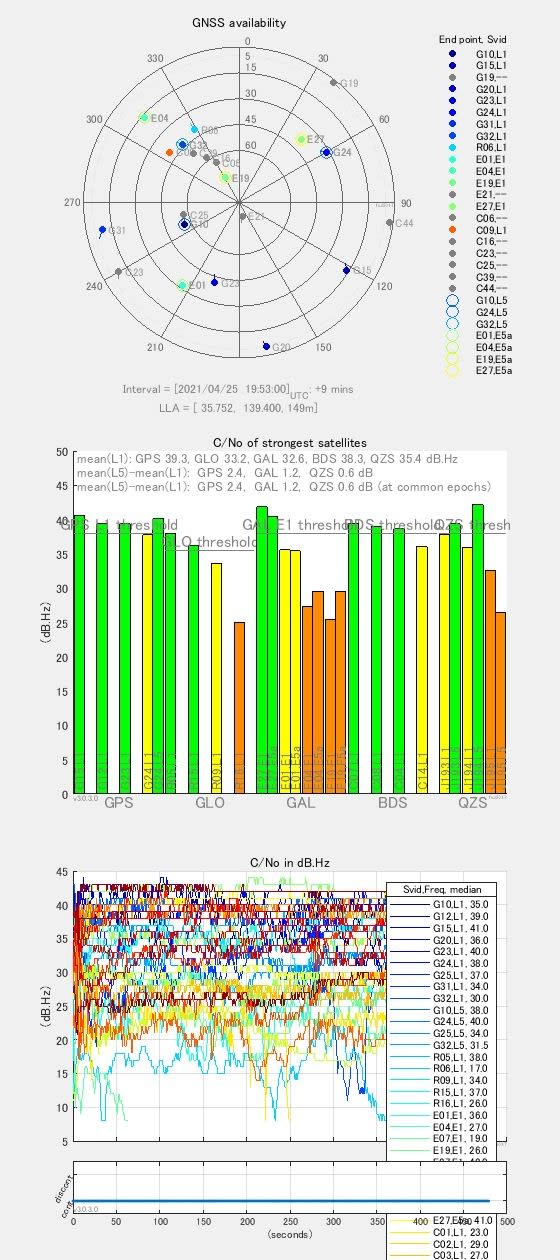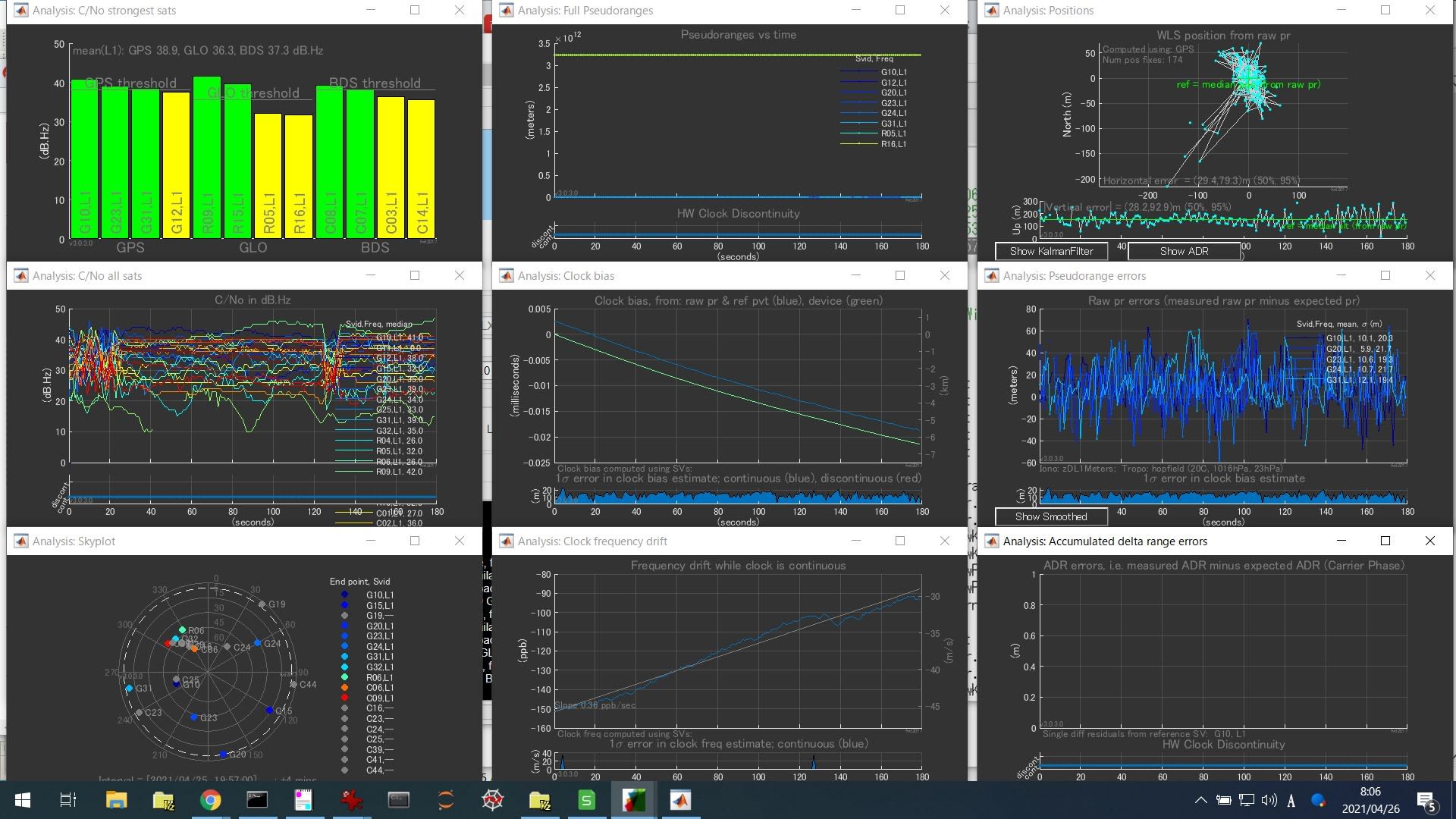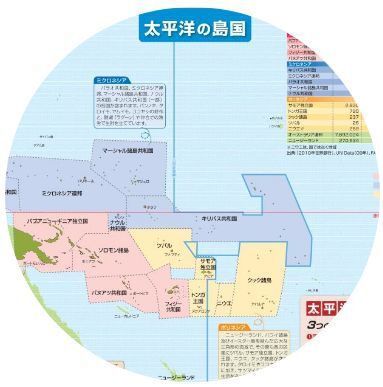2021.04.26 2周波GNSS受信スマホ Mate20Pro(2021.4.26.05JST)と単周波GNSS受信スマホ P30 lite(2021.4.26.05JST)のRawdata 測定結果比較(1) ではスマホGNSS受信のレベルの評価をしてみます。
スマホ受信C/No の比較
These plots show
1) Satellites available above the horizon
Gray dot means the satellite was above the horizon, but not tracked.
2) Carrier to Noise Density ratio (C/No) of the strongest satellites
above 5 degrees elevation (bar graph)
Each bar shows the median C/No for that satellite signal.
3) C/No of all satellites above 5 degrees elevation (line graph)
◎ 2周波GNSS受信スマホ Mate20Pro(2021.4.26.05JST)

上図および以下のC/Noレベル評価メモからMate20ProではGPSとガリレオとQZSSではL1+L5の2周波GNSS受信ができていることが分かります
The GPS reference threshold is set to 38 dBHz. Well built phones,
in open sky, have GPS satellites stronger than this threshold.
GLONASS threshold is 2.5dB lower, since GLO signal is 2.5dB weaker,
(see GPS and GLONASS ICDs).
For your log file the C/No results are:
GPS(L1), mean of strongest 4 mean C/No = 39.3 dBHz
Pass/fail reference threshold = 38.0 dBHz
GPS(L5), mean of corresponding L5 C/No = 40.1 dBHz
PASS
GLO(L1), mean of strongest 4 mean C/No = 33.2 dBHz
Pass/fail reference threshold = 35.5 dBHz
Error: L1 signals -2.3 dB compared to reference
FAIL BECAUSE OF WEAK SIGNALS
GAL(E1), mean of strongest 4 mean C/No = 32.6 dBHz
Pass/fail reference threshold = 38.0 dBHz
GAL(E5), mean of corresponding L5 C/No = 33.7 dBHz
Error: L1 signals -5.4 dB compared to reference
FAIL BECAUSE OF WEAK SIGNALS
BDS(L1), mean of strongest 4 mean C/No = 38.3 dBHz
Pass/fail reference threshold = 38.0 dBHz
PASS
QZS(L1), mean of strongest 3 mean C/No = 35.4 dBHz
Pass/fail reference threshold = 38.0 dBHz
QZS(L5), mean of corresponding L5 C/No = 36.0 dBHz
Error: L1 signals -2.6 dB compared to reference
FAIL BECAUSE OF WEAK SIGNALS

◎単周波GNSS受信スマホ P30 lite(2021.4.26.05JST)
These plots show
1) Satellites available above the horizon
Gray dot means the satellite was above the horizon, but not tracked.
2) Carrier to Noise Density ratio (C/No) of the strongest satellites
above 5 degrees elevation (bar graph)
Each bar shows the median C/No for that satellite signal.
3) C/No of all satellites above 5 degrees elevation (line graph)

The GPS reference threshold is set to 38 dBHz. Well built phones,
in open sky, have GPS satellites stronger than this threshold.
GLONASS threshold is 2.5dB lower, since GLO signal is 2.5dB weaker,
(see GPS and GLONASS ICDs).
For your log file the C/No results are:
GPS(L1), mean of strongest 4 mean C/No = 38.9 dBHz
Pass/fail reference threshold = 38.0 dBHz
PASS
GLO(L1), mean of strongest 4 mean C/No = 36.3 dBHz
Pass/fail reference threshold = 35.5 dBHz
PASS
BDS(L1), mean of strongest 4 mean C/No = 37.3 dBHz
Pass/fail reference threshold = 38.0 dBHz
Error: L1 signals -0.7 dB compared to reference
FAIL BECAUSE OF WEAK SIGNALS

イロイロとスマホ2周波GNSS受信レベルの段階で調整・検討すべき点があることが見えてきました。
スマホ受信C/No の比較
These plots show
1) Satellites available above the horizon
Gray dot means the satellite was above the horizon, but not tracked.
2) Carrier to Noise Density ratio (C/No) of the strongest satellites
above 5 degrees elevation (bar graph)
Each bar shows the median C/No for that satellite signal.
3) C/No of all satellites above 5 degrees elevation (line graph)
◎ 2周波GNSS受信スマホ Mate20Pro(2021.4.26.05JST)

上図および以下のC/Noレベル評価メモからMate20ProではGPSとガリレオとQZSSではL1+L5の2周波GNSS受信ができていることが分かります
The GPS reference threshold is set to 38 dBHz. Well built phones,
in open sky, have GPS satellites stronger than this threshold.
GLONASS threshold is 2.5dB lower, since GLO signal is 2.5dB weaker,
(see GPS and GLONASS ICDs).
For your log file the C/No results are:
GPS(L1), mean of strongest 4 mean C/No = 39.3 dBHz
Pass/fail reference threshold = 38.0 dBHz
GPS(L5), mean of corresponding L5 C/No = 40.1 dBHz
PASS
GLO(L1), mean of strongest 4 mean C/No = 33.2 dBHz
Pass/fail reference threshold = 35.5 dBHz
Error: L1 signals -2.3 dB compared to reference
FAIL BECAUSE OF WEAK SIGNALS
GAL(E1), mean of strongest 4 mean C/No = 32.6 dBHz
Pass/fail reference threshold = 38.0 dBHz
GAL(E5), mean of corresponding L5 C/No = 33.7 dBHz
Error: L1 signals -5.4 dB compared to reference
FAIL BECAUSE OF WEAK SIGNALS
BDS(L1), mean of strongest 4 mean C/No = 38.3 dBHz
Pass/fail reference threshold = 38.0 dBHz
PASS
QZS(L1), mean of strongest 3 mean C/No = 35.4 dBHz
Pass/fail reference threshold = 38.0 dBHz
QZS(L5), mean of corresponding L5 C/No = 36.0 dBHz
Error: L1 signals -2.6 dB compared to reference
FAIL BECAUSE OF WEAK SIGNALS

◎単周波GNSS受信スマホ P30 lite(2021.4.26.05JST)
These plots show
1) Satellites available above the horizon
Gray dot means the satellite was above the horizon, but not tracked.
2) Carrier to Noise Density ratio (C/No) of the strongest satellites
above 5 degrees elevation (bar graph)
Each bar shows the median C/No for that satellite signal.
3) C/No of all satellites above 5 degrees elevation (line graph)

The GPS reference threshold is set to 38 dBHz. Well built phones,
in open sky, have GPS satellites stronger than this threshold.
GLONASS threshold is 2.5dB lower, since GLO signal is 2.5dB weaker,
(see GPS and GLONASS ICDs).
For your log file the C/No results are:
GPS(L1), mean of strongest 4 mean C/No = 38.9 dBHz
Pass/fail reference threshold = 38.0 dBHz
PASS
GLO(L1), mean of strongest 4 mean C/No = 36.3 dBHz
Pass/fail reference threshold = 35.5 dBHz
PASS
BDS(L1), mean of strongest 4 mean C/No = 37.3 dBHz
Pass/fail reference threshold = 38.0 dBHz
Error: L1 signals -0.7 dB compared to reference
FAIL BECAUSE OF WEAK SIGNALS

イロイロとスマホ2周波GNSS受信レベルの段階で調整・検討すべき点があることが見えてきました。














